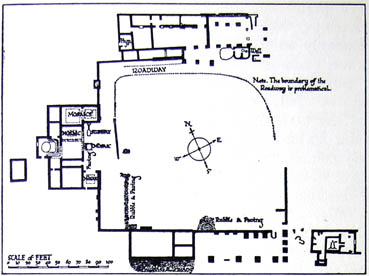|

Fig 5 Villa at Brading, Isle of
Wight
(For plan with numbered rooms, V.C.H. Hants, i, 313)
|
built apart to avoid danger of fire. At Mansfield
Woodhouse, in Nottinghamshire, two buildings make up the
establishment. The one is a small corridor house, with a hypocaust
and mosaic pavements, presumably the master’s residence. The other
is a specimen of the fourth type described above, less luxurious
than the corridor house, but containing some bathrooms, which
perhaps belonged to |
|
the conveniences of ‘the family.’ Elsewhere,
as at Clanville, we find something simpler. A house of our fourth
type provides the residence, and barns and sheds stand round it. In
all these types and combinations of types the larger houses seem to
contain accommodation both for a resident—or occasionally
resident—lord and his family and servants and for the farm
labourers and farm work. The smaller could have taken only working
farmers or bailiffs.
Besides these country-houses with their annexes, we
find also in the country various villages, or rather hamlets, which
stand apart from the houses just described and were inhabited only
by peasants. These have not yet been excavated in sufficient numbers
to form the basis of any general statement. We are not, however,
altogether without evidence. Three hamlets uncovered by General
Pitt-Rivers in north-east Dorset tell us the character of the
village life in that part of the province. The hamlets are small in
size—averaging about 150 yards across—irregular in shape, and
encircled, and to some extent divided up internally, by mounds and
ditches. The interior is thinly occupied by scattered cottages which
represent something far ruder than any of our four types of country
houses. Many are mere round huts, sunk slightly into the ground,
walled with wattle and daub, and comparable, perhaps, with the
‘mardelles’ of the Romano-Gaulish peoples across the Channel.
Others show more civilization—straight sides, regularly timbered
walls with painted wall-plaster, roofs of Roman tiles or slates from
Purbeck, and even simple attempts at hypocausts, while their
furniture includes glass jugs, styli for writing and—most
significant feature to anyone who has travelled on the margins of
civilization—wooden chests of drawers with bronze ornamental
handles and bosses. The dwellers in these hamlets were peaceful
agriculturists who grew corn and kept flocks and herds of somewhat
undersized cattle and sheep. Extensive traces of their small square
fields have in recent years been revealed on the Wiltshire, Dorset,
and Sussex downs by air-photography. How many persons went to a
hamlet we have no means of judging. But the hamlets themselves seem
to have been very numerous. They are now most easily detected on the
open downs. But |